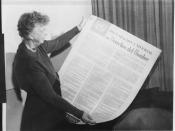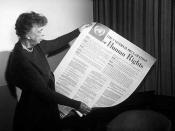The Bill of Rights and the Universal Declaration of Human Rights are two vital documents dedicated to the safety, security, and overall well-being of two very different groups of people. The Bill of Rights was simply the first ten amendments of the United States Constitution, whereas the Universal Declaration of Human Rights was made for all of the people governed by the separate and independent nations included in the United Nations. The key difference in the documents rests not in the words, but in the audiences to which they speak to and of. Comparing the one complete declaration of laws, Universal Declaration of Human Rights, and part of another, Bill of Rights as part of the US Constitution, is very different from a comparison of both documents as a whole. I will look specifically to the Articles presented in the Universal Declaration of Human Rights and not the Preamble to compare and contrast with the Bill of Rights.
The Universal Declaration of Human Rights uses much more ambiguous but universally acceptable terminology, because it is speaking for the rights of millions of people worldwide of many races and ethnic and religious backgrounds. This cannot be attained without using words and laws that can be accepted by the persons of all the member countries. Article ten is a perfect example of this because it combines the ideas of two of the Bill of Rights Amendments, numbers six and seven, and forms a much more universally acceptable law. Article ten pertains to rights of a speedy trial as well as a trial by jury. It is also important to understand that while some things need to be said more open-ended for the world to understand it, it is just as important for some of the articles to be much more...


